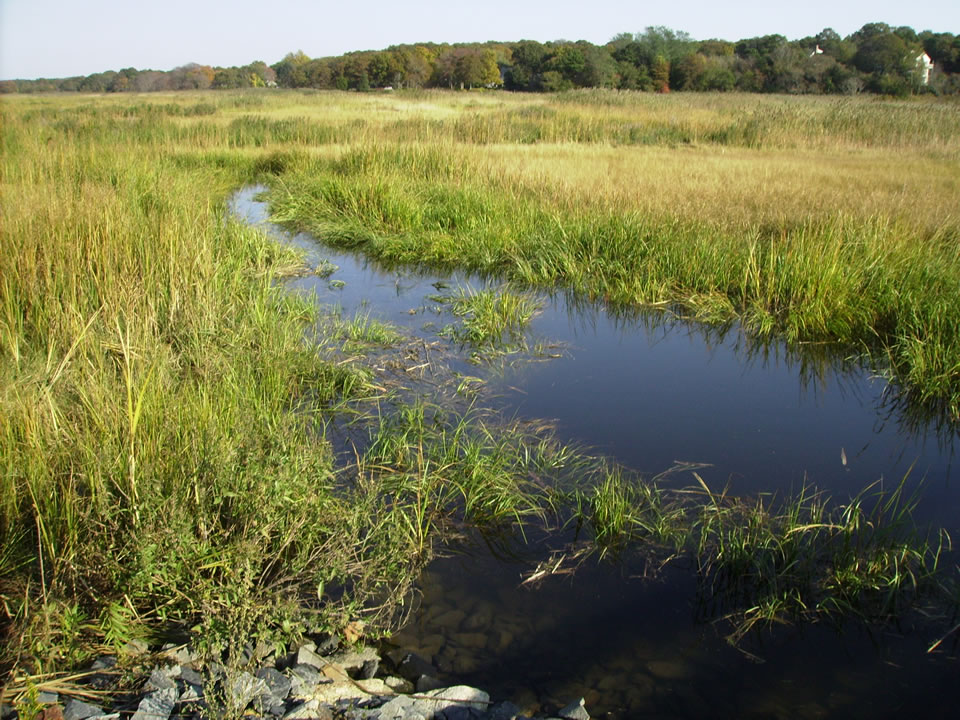Ecosystem Restoration Program

What is Restoration
The term “restoration” refers to the practice of ecological restoration, which entails the implementation of projects to restore ecological function to natural systems to the fullest extent possible. Restoration projects may entail removal of tidal restrictions and barriers to fish passage to restore habitat connectivity, installation of stormwater treatment practices to reduce pollutant input to waterbodies, rebuilding of dunes and barrier beaches to decrease flooding and coastal erosion, management of invasive vegetation, or improvement of water quality in freshwater ponds and streams.
Coastal development and pollution of our waterways from stormwater runoff, excess nutrients (nitrogen) from fertilizer use and septic systems have significantly impaired our coastal ecosystems. Poor water quality and alterations of the natural flow of water have damaged important habitat for fish, shellfish, and wildlife and have reduced the area of natural salt marshes, leaving shorelines more vulnerable to storm surge and sea level rise. However, we can reduce the nitrogen entering our waterways through various means and can design and implement projects that will directly restore salt marshes, fish runs and shellfish beds. In doing so we will re-establish the natural function of these areas, which in turn will benefit the local economy and our coastal way of life.
Salt marshes are the most productive ecosystems on earth! Salt marsh vegetation captures the sun’s energy and converts it to food for a plethora of creatures that in turn are food for others in a complex food web.
Salt marshes serve as nurseries for fish and countless marine creatures. The vegetation and roots capture sediment and fortify the shoreline against erosion. Salt marshes slow down the energy of waves generated by storms and buffer the mainland. Salt marshes filter out impurities from upland sources and bind heavy metals in their sediments for hundreds, even thousands of years. And, healthy coastal wetlands hold on to carbon keeping it out of the atmosphere, which would otherwise contribute to the warming of the earth.
For a variety of reasons our natural systems have been altered. Salt marshes have become degraded by uncontrolled, untreated stormwater runoff. They have been ditched and drained for the control of mosquitos, for agricultural purposes, and filled for development. Dikes and undersized culvert pipes installed decades ago now impede the natural flow of the tides resulting in loss of salt marshes and have given invasive species an advantage.
Healthy salt marshes are essential for sustainable fisheries, shellfish and wildlife habitat, for preventing coastal erosion, and for reducing nutrients. Cape Cod has lost over 36% of its salt marshes to human activities. Restoring lost and impaired salt marsh is imperative for our economy, environment, and resilience.
Our coastal wetlands play a critical role in the life cycle of river herring. Herring spend their adult life in the ocean; however, they must find their way to the Cape’s freshwater ponds to spawn for the next generation of herring. Often these small streams that connect the ocean to the ponds have become degraded or closed off due to past human activities. Restoring the fish runs will improve the herring populations which in turn serve as an important food source for larger fin fish and commercial fishing.
What is APCC Doing To Help?
In 2015, APCC established the Restoration Coordination Center (RCC), now referred to as APCC’s Ecosystem Restoration Program (ERP), to help towns and communities on Cape Cod with prioritization, planning, implementation, and management of restoration projects. APCC has since met with staff from all 15 Cape towns and identified over 170 restoration projects that towns want to undertake but lack the resources to implement These projects include restoration of impaired salt marshes, fish runs and shellfish beds, as well as stormwater projects to improve water quality and habitat.
The goal of APCC’s ERP is to increase the number and success rate of important coastal wetland restoration projects by serving as a resource and management center. The ERP also aims to build public support for restoration to improve our natural resources and environment. Our comprehensive inventory of restoration projects will serve as the basis for prioritizing projects and helping communities to undertake restoration projects.
Ecosystem Restoration Program Project Inventory Map
Through meetings with all 15 Cape towns the Ecosystem Restoration Program has compiled an inventory of more than 170 restoration projects. These projects include salt marsh, pond, stream, wetland, and fish run restorations as well as stormwater and coastal resilience improvements. The inventory includes both identified potential projects as well as others that are actively underway with planning, permitting, design or construction. The map will be updated regularly as new projects are added to the inventory and as the status of existing projects changes. The purpose of this inventory and associated map is to serve as a regional resource to help identify projects in need of assistance and prioritize projects for implementation. By clicking points on the map you can access basic info about each project including name, type, and description.
Partners
As a Cape-wide organization, APCC is working with existing partnerships to develop the Restoration Coordination Center and to expand on previously developed coordination efforts. Key partners supporting the Center include:
- Massachusetts Division of Ecological Restoration
- Massachusetts Bays National Estuary Program
- Cape Cod Commission
- Cape Cod Conservation District and Natural Resources Conservation Service
- Barnstable County Coastal Resources Committee
- Massachusetts Division of Marine Fisheries
- The 15 towns on Cape Cod
- The Mashpee Wampanoag Tribe
Funding provided by The Cape Cod Five Cents Savings Bank Charitable Foundation Trust, The Cape Cod Foundation through the Dolphin Fund for Cape Cod, Environmental Trust Fund of Cape Cod, Permanent Freshwater Fund, and the Patricia Gidley-Price Fund, the MassBays National Estuary Program, EPA Grant No. CE96173901, and APCC membership support.
